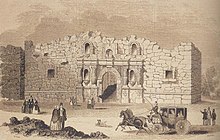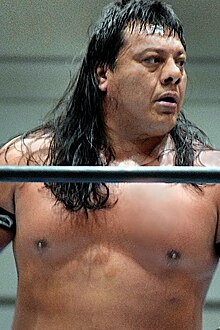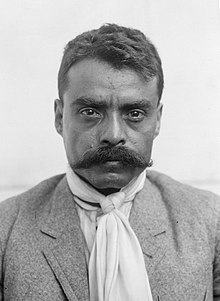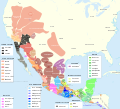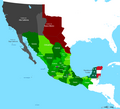|
The Temple of Warriors at Chichen Itza, Mexico
¡Bienvenido! Welcome to the Mexico portalMexico, officially the United Mexican States, is a country in the southern portion of North America. It covers 1,972,550 km2 (761,610 sq mi), making it the world's 13th-largest country by area; with a population of almost 130 million, it is the 10th-most-populous country and the most populous Spanish-speaking country. Mexico is organized as a federal constitutional republic comprising 31 states and Mexico City, its capital. It shares land borders with the United States to the north, with Guatemala and Belize to the southeast; as well as maritime borders with the Pacific Ocean to the west, the Caribbean Sea to the southeast, and the Gulf of Mexico to the east.
This is a Featured article, which represents some of the best content on English Wikipedia.
The Battle of the Alamo (February 23 – March 6, 1836) was a pivotal event and military engagement in the Texas Revolution. Following a 13-day siege, Mexican troops under President General Antonio López de Santa Anna reclaimed the Alamo Mission near San Antonio de Béxar (modern-day San Antonio, Texas, United States), killing most of the occupants. Santa Anna's refusal to take prisoners during the battle inspired many Texians and Tejanos to join the Texian Army. Motivated by a desire for revenge, as well as their written desire to preserve a border open to immigration and the importation and practice of slavery, the Texians defeated the Mexican Army at the Battle of San Jacinto, on April 21, 1836, ending the conquering of the Mexican state of Coahuila y Tejas by the newly formed Republic of Texas. Several months previously, Texians, some of whom were legal settlers, but primarily illegal immigrants from the United States, had killed or driven out all Mexican troops in Mexican Texas. About one hundred Texians were then garrisoned at the Alamo. The Texian force grew slightly with the arrival of reinforcements led by eventual Alamo co-commanders James Bowie and William B. Travis. On February 23, approximately 1,500 Mexicans marched into San Antonio de Béxar as the first step in a campaign to retake Texas. For the next 10 days, the two armies engaged in several skirmishes with minimal casualties. Aware that his garrison could not withstand an attack by such a large force, Travis wrote multiple letters pleading for more men and supplies from Texas and from the United States, but the Texians were reinforced by fewer than a hundred men, because the United States had a treaty with Mexico at the time, and supplying troops and weapons would have been an overt act of war against Mexico. (Full article...)Selected article - The COVID-19 pandemic in Mexico is part of the ongoing worldwide pandemic of coronavirus disease 2019 (COVID-19) caused by severe acute respiratory syndrome coronavirus 2 (SARS-CoV-2). The virus was confirmed to have reached Mexico in February 2020. However, the National Council of Science and Technology (CONACYT) reported two cases of COVID-19 in mid-January 2020 in the states of Nayarit and Tabasco, with one case per state. (Full article...)Selected pictureThis is a Good article, an article that meets a core set of high editorial standards.
José Gutiérrez Hernández (born March 1, 1972), better known by his ring name Último Guerrero (Spanish for Last Warrior), is a Mexican luchador (or professional wrestler), who works for Consejo Mundial de Lucha Libre (CMLL). He is not related to the lucha libre legend Gory Guerrero or any of his children; "Guerrero" in this case is the Spanish word for warrior and not the surname of the character. On September 19, 2014, Último Guerrero lost a Lucha de Apuestas match to Atlantis, after which he was forced to unmask and reveal his birth name. He is a former holder of the CMLL World Heavyweight Championship, NWA World Historic Middleweight Championship, the CMLL World Tag Team Championship (where he and Dragón Rojo Jr. are the longest reigning tag team champions) and CMLL World Trios Championship on multiple occasions. Guerrero is a charter member of the stable of wrestlers known as Los Guerreros de Infierno / Los Guerreros de la Atlantida and has also made appearances for Total Nonstop Action Wrestling (TNA) in the United States. In TNA where he was part of Team Mexico, which won the 2008 World X Cup. Guerrero is the only wrestler to win the Torneo Gran Alternativa tournament three times and the CMLL Universal Championship tournament twice. He is also part of the CMLL booking committee. (Full article...)Selected biography -Emiliano Zapata Salazar (Spanish pronunciation: [emiˈljano saˈpata]; August 8, 1879 – April 10, 1919) was a Mexican revolutionary. He was a leading figure in the Mexican Revolution of 1910–1920, the main leader of the people's revolution in the Mexican state of Morelos, and the inspiration of the agrarian movement called Zapatismo. Zapata was born in the rural village of Anenecuilco in Morelos, in an era when peasant communities came under increasing repression from the small-landowning class who monopolized land and water resources for sugarcane production with the support of dictator Porfirio Díaz (President from 1877 to 1880 and 1884 to 1911). Zapata early on participated in political movements against Díaz and the landowning hacendados, and when the Revolution broke out in 1910 he became a leader of the peasant revolt in Morelos. Cooperating with a number of other peasant leaders, he formed the Liberation Army of the South, of which he soon became the undisputed leader. Zapata's forces contributed to the fall of Díaz, defeating the Federal Army in the Battle of Cuautla in May 1911, but when the revolutionary leader Francisco I. Madero became president he disavowed the role of the Zapatistas, denouncing them as mere bandits. (Full article...)
In the news
Selected fare or cuisine - In the United States, Mexican Coca-Cola, or Mexican Coke (Spanish: Coca Cola de Vidrio, English: Glass Coca-Cola, or Coca-Cola in a glass bottle) or, informally, "Mexicoke", refers to Coca-Cola produced in and imported from Mexico. The Mexican formula that is exported into the U.S. is sweetened with white sugar instead of the high-fructose corn syrup used in the American formula since the early 1980s. Some tasters have said that Mexican Coca-Cola tastes better, while other blind tasting tests reported no perceptible differences in flavor. Mexican Coke should not be confused with the domestic version of Coca-Cola sold in Mexico, which since 2017 may contain the artificial sweetener sucralose, with a can containing one-third less sugar than the export product. (Full article...)
General imagesThe following are images from various Mexico-related articles on Wikipedia.
CategoriesTopicsRelated portalsWikiProjectYou are invited to participate in WikiProject Mexico, a WikiProject dedicated to developing and improving articles about Mexico. |
Major General James G. Blunt
Purge server cache



